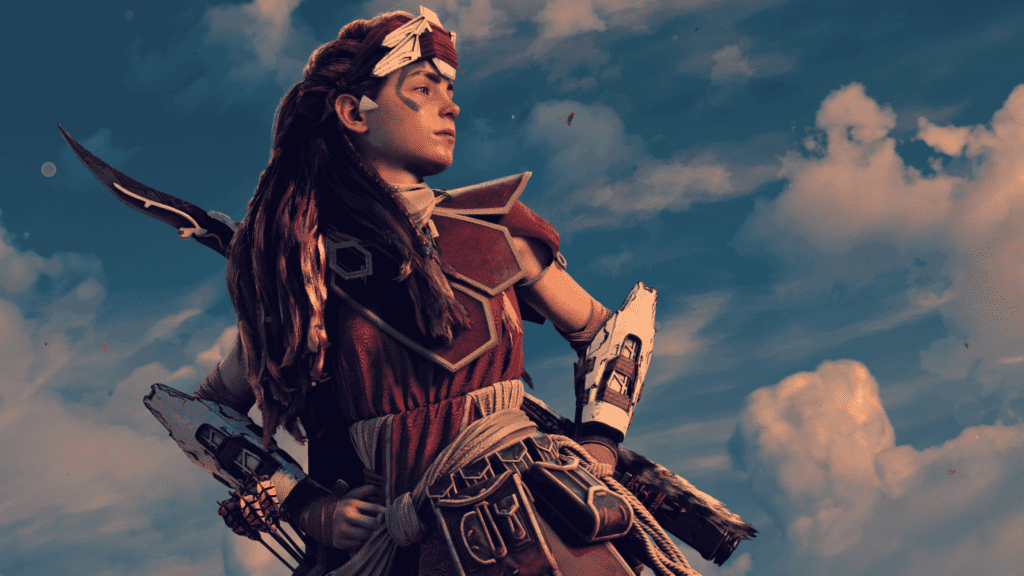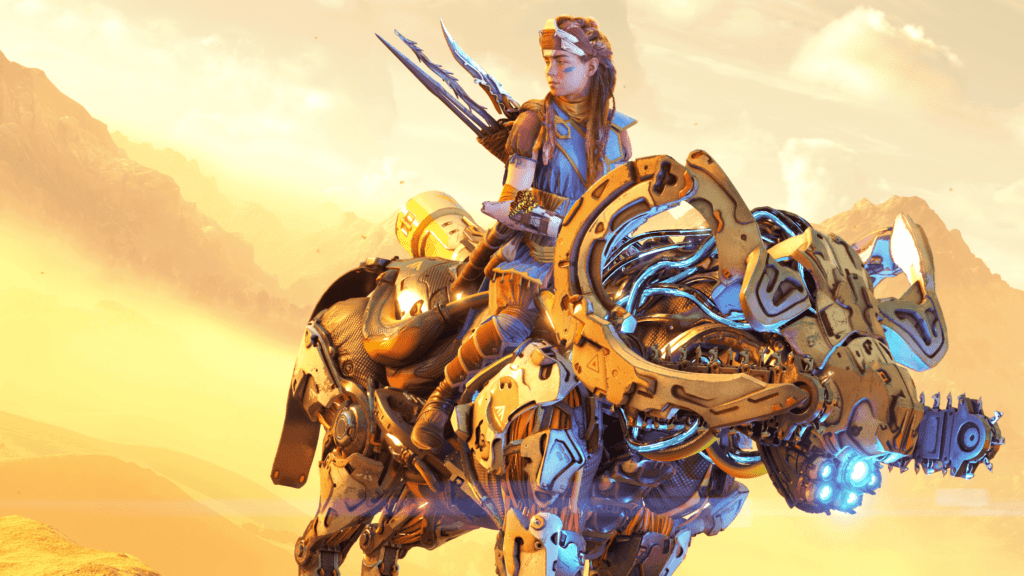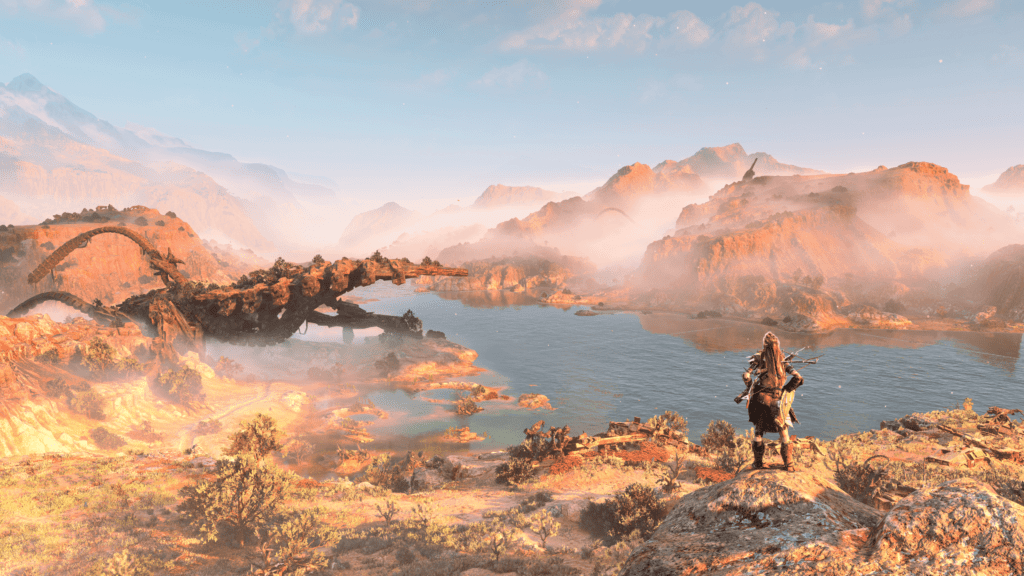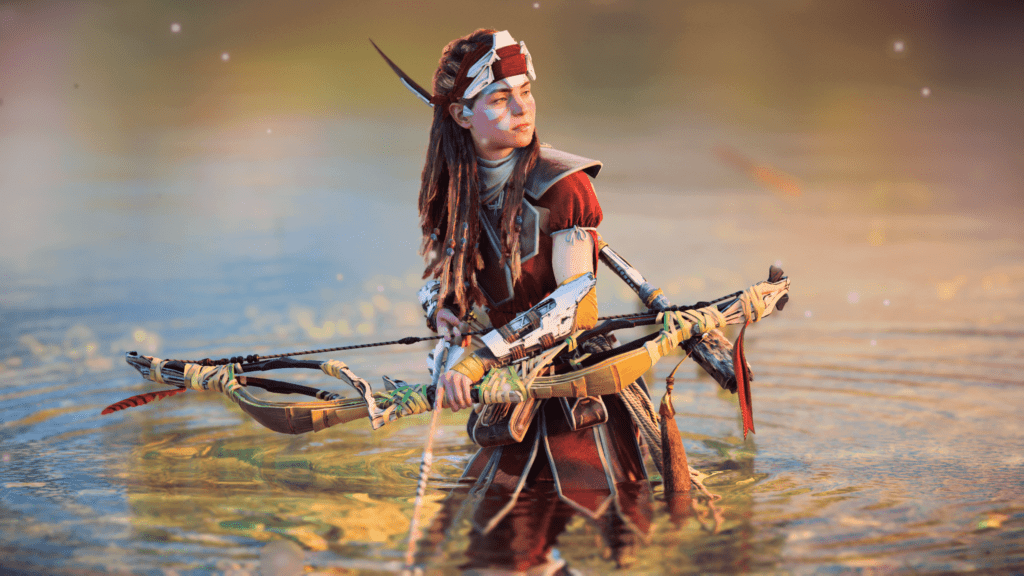Before the likes of Ghost of Tsushima and The Last of Us Part II closed the book on a generation of PlayStation 4 exclusives, the release of Horizon: Zero Dawn in 2017 underscored the start of a new era for developer Guerrilla Games. Horizon was a totally different beast compared to the shooter-heavy back catalogue that Guerrilla had become known for and a complete departure from the Killzone series entirely. It wasn’t, however, the wildest possible pivot that Guerrilla could’ve made. Zero Dawn was an open-world adventure game that debuted in a genre that had already been largely demarcated by a notable group of established series’. It entered a space where a creeping level of homogenisation had left many otherwise diverse experiences feeling inherently similar. And it shared a release window with Nintendo Switch exclusive The Legend of Zelda: Breath of the Wild, a game often lauded for being one of the few within the genre to really challenge convention. Zero Dawn didn’t break the mould, but it did successfully navigate several of the pitfalls posed by the mainstream titles that it followed. Horizon: Forbidden West, it’s 2022 sequel, still had to tackle many of the same impediments that the original faced—not least its release alongside another critically acclaimed open-world title in the form of FromSoftware’s Elden Ring—yet it did so with a much better understanding of where exactly it intended to fit in amongst so many other major names. Bolstered by the collective experience of Zero Dawn, its sole DLC The Frozen Wilds, and the development of a virtual reality spin-off, Forbidden West boasts the self-assurance of a series that has broken into a comfortable stride and the level of technical expertise befitting a marquee title for Sony’s fledgling PlayStation 5.
As the name suggests, Forbidden West moves things from the eastern states of Arizona and Colorado across the country to places like Nevada and California. The game space isn’t just bigger than that of Zero Dawn, but also much more multifaceted. There’s depth to the map in ways that there wasn’t before—sunken ruins can now be fully explored in gorgeous underwater environments, while the addition of both flying mounts and the shieldwing glider give a wonderful perspective of the world from above. The West feels a lot more lived in, too. Strangers posted outside of campsites mark your map with places of interest for you to visit. Ambushing rebels are prone to striking as soon as your guard is down, with spontaneous skirmishes breaking out between rival clans at the drop of a hat. And emergent investigations will have you revealing the fate of a fallen band of hunters, or lead you right to a stash of valuable supplies. Most impressive of all is the way in which Forbidden West continues to delve deeper into its technologically-charged history, and in particular, the importance it places upon the past when introducing entirely new cultures to its landscape. Be it through a complete mission strand or even an offbeat fragment of dialogue, the marriage of the past and present is as important for the sake of authenticity as it is the extent with which players can engage with the broader aspects of the lore. Beyond the exhilarating duels against robotic beasts and the exploration of a fallen world, Forbidden West reiterates Zero Dawn’s knack for the minutiae by having Aloy, and especially her group of allies, make observations and connections about the old world in a way that parallels directly with our own. Little by little, the will to unearth the unknown becomes as much of a driving force as the pursuit of a villain or the daunting challenge of colossal machines, and it’s through that lens of gradual understanding that Forbidden West is able to completely immerse you in the complexities and nuances of its world.
IT TAKES A LITTLE WHILE FOR YOU TO EARN YOUR WINGS. BE IT ON THE BACK OF A FLYING MACHINE OR HANGING FROM A GLIDER, THE WEST IS BREATHTAKING FROM ABOVE
Visually, Forbidden West pairs immaculate graphical fidelity with the most remarkable motion capture and character animation that perhaps the medium is yet to see. In Zero Dawn, Aloy comes across as a little wooden, which led to her seeming too neutral and inexpressive in many instances. In Forbidden West however, Aloy’s personality has been given the exact tools it needs to blossom, with the wonderfully emotive voice acting of Ashly Burch working in perfect harmony alongside the colourfully evocative quirks and motions of her protagonist. Cutscenes are truly a feast for the eyes, not just as a result of the spectacularly well-delivered acting that propels them, but also because of the unmatched level of detail afforded to character designs. The cultural diversity of the West’s inhabitants is visible in every weave and adornment of their attire, with the motifs of each tribe inspired by the unique characteristics of their environment. Aloy’s character model in particular is impressively adaptive. When subjected to the sweltering heat of the desert, she will realistically perspire, and when drenched in woodland rain, her hair will glisten and her armor will shimmer in the wet. Living rough has even made its mark on her complexion, most notably in the way that prolonged sun exposure has caught her skin and reddened her in the face. Whether it’s the smaller intricacies that otherwise may go unnoticed or the grander examples of environmental sculpting, the entire palate of visual design showcased in Forbidden West is a feat of pure artistic prowess. The West is just as wonderfully vibrant beneath a veil of morning mist as it is in the midst of desert sandstorm, and there’s seemingly nothing in the game that hasn’t seen the attention of the artist’s brush.
Both Zero Dawn and Forbidden West tick plenty of the usual boxes when it comes to your typical open-world fare. Here in the sequel however, side-content that isn’t driven by the narrative is much more of a mixed bag. The new open-world puzzle sections are fun enough, if a little obtuse on occasion. Yet clearing out over a dozen similarly structured enemy encampments is just about as compelling as can be expected. Vista Points, a highlight of Zero Dawn, have oddly been downgraded to being little more than virtual postcards, while textual and audio datapoints also reprise their role as unimaginative filler. Although the collecting of coffee cups may have only been substituted for the pilfering drone data or gathering of holographic projectors, it’s the bigger, bolder diversions that make the best impression. The focused challenges of the hunting grounds’ are as enjoyable as ever, which is exactly why it was so deflating to find that there were only 4 of them in total across the entire map. The arena picks up a bit of the slack here, but trades in objective-based goals for an unmatched onslaught of flying arrows and shredded steel. That you don’t consume any sort of ammunition in the arena really puts it on a pedestal all its own. Ranged combat is still one of the series’ crowning jewels, and to freely engage in it without the worry of depleting any resources is really quite cathartic. What’s more, with a record nine different weapon archetypes available, the arena is also a fitting proving ground for measuring your latest acquisitions up against your current load-out choices. It’s Tallnecks that once again steal the spotlight though, with their return in Forbidden West outlined by a whole new dynamic integrated into their design. Tallnecks are still utilised for the purpose of clearing map fog, but accessing them is now locked behind the completion of a unique environmental puzzle. One Tallneck is submerged in the sea, its power cells having been displaced by a pack nearby metal albatrosses. Another walks its route in a state of malfunction and needs to be anchored to the ground before it can be suitably repaired. With that extra layer of depth, Tallnecks now pose an adequate challenge that’s a far better fit for their colossal size, though the picturesque view of your surroundings from atop its precipice is still the best possible reward for your endeavour.
What separates this sequel from many other examples in the genre is the way in which story-driven secondary content fits in so neatly alongside the central experience. Chapter-like mission strands flow downstream from the main narrative, breaking off into contained storylines that explore smaller, grounded tales of inter-clan conflict and pre-war discovery. No quest feels as though it’s an improper fit and each plays a small part in suitably differentiating the West from the landscape already established by its predecessor. Aloy’s collective of allies remain at the heart of things throughout, with the colourful cast of characters at her back each the focal point of their own unique storyline. Side-quests of this nature progress in tandem with the main narrative, though even if you’re left to wait on the next mission trigger, the all-new home base gives you the chance to converse with your team and understand a little bit about their lives up until they first crossed paths with Aloy. While much of what the hub promises doesn’t quite meet its potential, it is undoubtedly the most valuable place in the game for delving into lore dumps and exploring character motivations. There’s plenty beneath the hood in Forbidden West to sate the appetite of even the most avid of explorers—it became a ritual of mine to exhaust every single sentence of optional dialogue whenever I returned to the base following a major quest. Given the deceptively short length of the main narrative though, side-quests hold a greater prominence as part of the larger experience. What’s more, as they’re evenly spliced in between the major beats of the story, they also present the best examples of unhurried, tempered pacing. Especially as you edge towards the game’s finale, there’s a sense that major story beats just aren’t given enough time to simmer. Cut-scenes roll out with greater abundance and antagonists are swatted aside with far too much haste. The finale of Zero Dawn felt conclusive because it leant more on the vanquishing of the foe in the present rather than focusing on the one that’s yet to come. Forbidden West is quite the opposite, and because of the forceful way with which it sets up the next instalment in the series, the events that transpire in its final moments are quickly passed over and undercut, the spotlight now pointed at a newer, more ominous foe than before.
Bow combat in Forbidden West is just as just as crisp and satisfying as you remember, and thanks to the addition of the new grapple hook, much more fluid too. The key differences from the original are in the broader repertoire of arrows, weapons and skills that Aloy can utilise, though the biggest change comes in the form of the overhauled melee system. There are multiple skills dedicated to melee now, and even a small quest-line designed to introduce you to the button combos that you’ll need to commit to memory. While melee can be a great tool for staggering nearby foes and lopping off machine parts, it struggles to match the level of precision and responsiveness of anything that involves a bow. The biggest problem is that its combo-system uses so few different buttons, meaning that there’s simply too much information spread across so few inputs. Reliably executing a specific attack is frustratingly difficult due to different combos intersecting with one another, which leads to timing-dependant commands being easily missed as a result. Melee combat is also far too floaty and completely gives up the feeling of weightiness that bows replicate so well. When swinging her spear for a melee attack, Aloy glides across the ground as though it’s covered in a slick sheet of ice and her strikes all land with the same unfulfilling metal ding. It’s a relief then that your dependence on melee attacks can be easily circumvented through a refined understanding of movement. Between gliding, grappling, running and sliding, there are still plenty of ways to distance yourself from a machine and regain control of a battle that don’t depend on you aimlessly swinging your spear.
THE INHABITANTS OF THE WEST REALLY HELP BRING IT TO LIFE. EVERYTHING FROM THE CHARACTER ANIMATIONS TO CLAN-SPECIFIC COSTUME DESIGN IS HUGELY IMPRESSIVE
Bows and other ranged weapons are instead maligned by a messy user interface and an unimaginative upgrade system. Switching arrow types on the fly is easy enough, though by the time that you begin the utilise all of the weapon slots available to you, the amount of information displayed by the weapon wheel quickly becomes overwhelming. With so much iconography jam-packed into such a small space, it’s often difficult to find exactly what you’re looking for at a glance. Even selecting the right arrow type can be a challenge in itself, with just one errant nudge of the stick landing you on the wrong choice and needing to delve into the menu once again. In the heat of battle, where bow shots flow into evasive dives and then into retaliatory strikes, the heavy reliance on frequently bringing up the weapon wheel is a detriment to the pace of combat, at least so as long as it remains so cumbersome. It’s the expected consequence of variety in many ways, where the necessity of harnessing every element is met with an arsenal of weapons as fun as they are unique. What wasn’t so expected was the overhaul of the upgrade system, which reduces improving weapons and gear into into little more than the fulfilment of a dozen different shopping lists. Targeting the same machine type over and over again in order to collect a specific part really undersells the typical enjoyment of combat when efficiency becomes the only meter of progress. Reducing machines to being mere material repositories also tends to narrow your style of play, and before long, even something with a design as unique as a Thunderjaw begins to lose its appeal as true marker for your strength. Modification slots also find themselves locked behind upgrade tiers which severely reduces your chance to play around with different elemental infusions prior to upgrading. And with no way to preview what a weapon or armour set will be like before dedicating all of your rare finds to its construction, there’s also a chance that your farming pursuits will have been for naught if the finished product doesn’t live up to its potential. The overarching problem here is that many of the intricacies underpinning the game’s stellar story elements leave a lot to be desired, and in that sense, Forbidden West ultimately hasn’t improved in the key areas that it really needed to.
One of Zero Dawn’s biggest successes was in the way it handled the pervading sense of mystery at the heart of its story. The unknowing of Aloy’s ancestry, the world around her and her role in the all-consuming conflicts to come catalysed a narrative that flourished as unfettered discovery brought to life its landscape of machines. Forbidden West doesn’t have the kind of advantages that its predecessor had. With so many secrets having already been revealed in Zero Dawn, that sort of grand discovery takes something of a backseat, resigned largely to audio fragments and supplementary conversational dialogue. It’s a different kind of mystery this time, one that struggles to really dig its hooks in and captivate in the same way that the story of Aloy’s origins did. The stakes are still as big as ever, though they aren’t supplemented by a parallel track of individual growth like before. Here, Aloy’s story continues as more of a reflection of the company she keeps, but stutters amidst an indecisive approach in how to best utilise her growing cabal of allies. Things aren’t helped by the way in which Forbidden West hurries itself to its conclusion either, along with the way in which the important beats of the story are rendered in choppy, uneven cutscenes. Where artistic direction is concerned, Forbidden West excels as a best-in-class open-world that captures the imagination and captivates with its beauty. Elsewhere, its reluctance to evolve in a way that really pushes the series forward sees it stagnate somewhat, with Aloy’s second outing leaning a little too heavily on the kind of conventions that Zero Dawn had succeeded in balancing so well.



